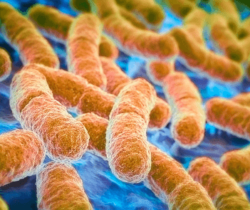How Listeria monocytogenes can survive in extreme environmental conditions
 It is difficult to eliminate L. monocytogenes from post processing contamination of food production lines since this pathogen is common in various environments outside processing plants, and can endure in food processing environments. It is one of the main concerns in environmental monitoring due to its ability to survive strict cleaning conditions and remain in the plant environment for months or even years.
It is difficult to eliminate L. monocytogenes from post processing contamination of food production lines since this pathogen is common in various environments outside processing plants, and can endure in food processing environments. It is one of the main concerns in environmental monitoring due to its ability to survive strict cleaning conditions and remain in the plant environment for months or even years.
Listeria monocytogenes has better survival ability than most other food pathogens, resulting in the colonization of Listeria in food processing environment. L. monocytogenes is capable of adapting to a variety of stress conditions, including pH variations, cold temperature, low water activity, high salt concentration, and different sanitizers such as quaternary ammonium compounds, sodium hypochlorite, and peracetic acid.
In the recent past, researchers have identified several hypervariable (easily changeable regions) regions of the bacterial genome called Genetic Insert Stress Survival Islet 1 (SSI-1). This genetic region exists in some other bacteria. Different genetic sequence inserts are utilized by the bacteria to help tolerate acidic conditions, bile salts, pH fluctuations, salt concentration, low water activity, temperature variations, etc. The SSI-1 is a five-gene islet that contributes to the growth of L. monocytogenes in sub-optimal conditions. However, SSI-1 does not explain the survival of L. monocytogenes during food sanitation conditions that are alkaline and highly oxidative.

In a recent publication by Harter et al., Sep 2017, it was reported that by looking at neighboring gene sequences to SSI-1, they identified a new stress survival islet 2 (SSI-2). SSI-2 is predominantly present in L. monocytogenes ST121 strains and is responsible for survival in alkaline conditions and oxidative conditions present in food processing environment.
Their study showed that SSI-2 is involved in a different stress response than SSI-1. The prevalence of SSI-1 is similar between clinical isolates and strains isolated from food and food processing environments. SSI-2 strains are mostly present in L. monocytogenes strains isolated from food and food processing environments (84%), and not from clinical isolates.
SSI-2 is mainly contained in strains of ST121, while SSI-1 is present in diverse ST strains. The CC121 are prevalent in isolates from food and processing environment and are very rare among clinical isolates. ST121 strains persist for months in food processing environment, due to their ability to survive the oxidative and alkaline conditions, potentially resulting in contamination of the environment. The authors speculate that SSI-2 seems to have developed in response to the cleaning regime of food processing, because of their much higher prevalence in this environment.
SSI-2 contains two genes (lin0464 and lin0465) that support survival under alkaline and oxidative conditions. One gene is a transcriptional regulator directing the entrance of the second gene which is responsible for protease activity (breaking down proteins during oxidative stress). The broken proteins can be eliminated from the cell relieving the stress.
The SSI-2 are called “stress survival islet,” since both genes help the survival under stress conditions. Under stress conditions, mRNA production increases, as is the increase in transcription of the putative protease gene.

Harter et al. hypnotize that elemental horizontal gene transfer from L. innocua is most plausibly integrated into the L. monocytogenes genome to create the SSI-2. This is because the two strains are more closely related than other strains of Listeria, and coexist in the same ecological niches.
L. monocytogenes ST121strains containing the SSI-2 genes survive the alkaline and oxidative stresses during cleaning and sanitation procedures. The oxidizing agents (e.g., chlorine dioxide, sodium hypochlorite, hydrogen peroxide) are frequently applied to kill bacteria on surfaces but can be survived by these strains of L. monocytogenes.
Progress has been made to better understand the genetic reasons for the survival of L. monocytogenes in food processing plants. To better understand the survival mechanisms of Listeria, and for the development of new strategies for prevention, these studies are essential.
